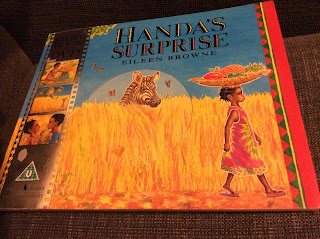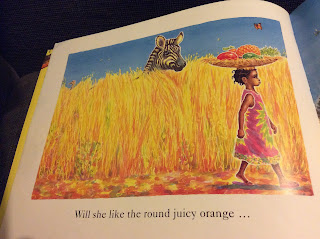Written by; Mary Hoffman
Illustrated by: Ros Asquith
Publisher: Frances Lincoln Children's Books, 2010
This book offers a sound contribution to promoting representations of diversity in children's literature, particularly around the topic of families. The Great Big Book of Families depicts, for example, how different families live, what they wear, the pets they have, how they educate their children, the festivals they celebrate, and the holidays they take (including staying at home, which sums up nicely how very inclusive representations in this book are). It's an empathetic book, with the author, Mary Hoffman, clearly being keen not to make assumptions about life in families in contemporary Britian. I like the fact that the book doesn't try to make the saccharine conclusion of 'we're all different, but deep down all the same', like many of its contemporary titles. this book is out and proud in celebrating difference.
The pen and watercolour cartoon-like illustrations (reminiscent of those by Laurence Anholt) offer depictions of people across a variety of ages, ethnicity, abilities, having different religious affiliations, and being both many and few in number (those with lots of siblings, and extended family members, those being so called 'only children'). For our 'blended family' (I'm borrowing this term to describe our part birth and part adopted children loveliness!), this book is useful, helping us frame a dialogue with our kids about what we look like, how we're composed as a family. The book includes a representations of families with two mums, two dads, adoptive and foster families. There are also lots of representations throughout the book of interracial families / multi ethnic families, so again, The Great Big Book of Families could be incredibly helpful in opening many dialogues.
The book hasn't had the greatest reception with my children though. It seems its useful, but overwhelming. The illustrations and layout of the pages are 'busy'; as with the page above, some nice depictions of 4-3 person families are distracted by additional stick-men border pictures. There's too much to see and too many ideas. Five pages in, my daughter, who will sit through very long children's books normally, get quite bored and frustrated with this book. Ironically, given it celebrates difference, she finds the catalogue/ categorising style narrative a little 'samey' saying latterly, 'it just about a lot of people all doing the same thing -standing about together.' On other pages there's a lot of 'items' or themed artifices in the boarder, and again I think she finds this 'clutter of the page' a little over stimulating.
A very positive aspect of the book are the many emotions the book explores, not only in the facial expressions of the pictures, but more explicitly in the last few pages of the book there's a nod to family members feeling differently from each other, disagreeing and even fighting, which again, might be very helpful to explore with little ones.
The gimmicky 'spot the cat' picture request on the book title page is again, distracting, and I think the opening page, which attempts to show children how representations of families have changed, goes beyond the point, and feels a bit self congratulating (in that the book attempts to redress this). On an aesthetic level, the type-font looks a bit cheap and spiky, and there are quantitatively a lot of pictures in the book that include written labels within the illustration (see the family tree page for example). At first I thought the book might therefore me better aimed at my seven year old able reader, who could get more out of the pictures, but he complains that in this book, 'there really is no story.' I have seen non-fiction -fiction hybrids on blended families, captivate much better: Eddie's Tent and How to Go Camping by Sarah Garland for example, and a non fiction such as Kids by Catherine and Laurence Anholt, captivate on the basis of using rhyme. this book is on the whole then, a bit busy in look and a bit bland in address (ironic really?!), but as said above, does make a very welcome and timely response to representing contemporary family life in the UK.







































